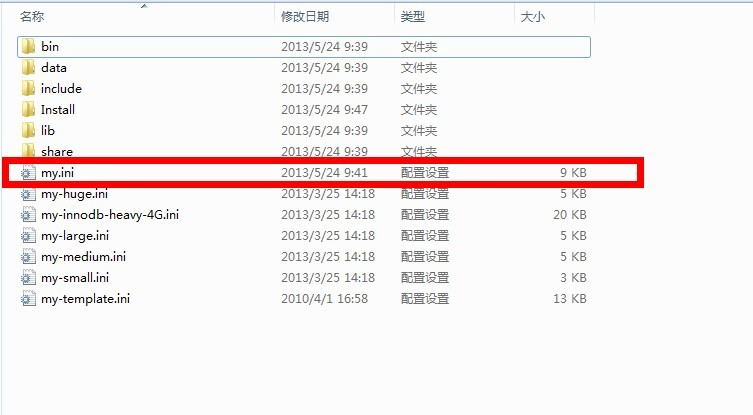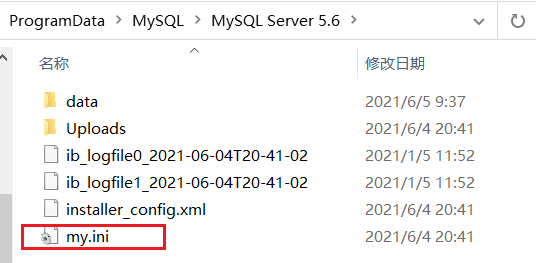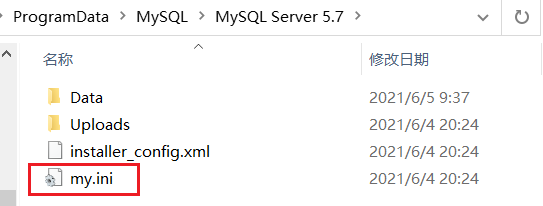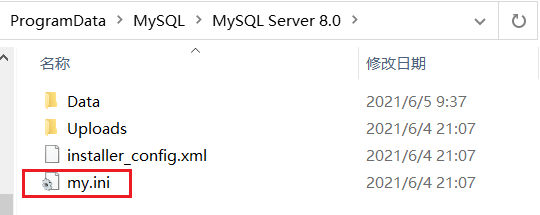一、MySQL的配置文件
1、my.ini 是什么
my.ini是MySQL数据库中使用的配置文件,修改这个文件可以达到更新配置的目的。
2、my.ini 存放在哪里
(1)以MySQL5.5为例,my.ini 存放在MySQL的安装的根目录

(2)以 MySQL5.6 | MySQL5.7 | MySQL 8.0 的配置文件存放在 C:ProgramData下面:




注意:修改完配置文件,一定需要重复 MySQL 服务。
二、my.ini 的配置文件内容
1 # MySQL Server Instance Configuration File
2 # ----------------------------------------------------------------------
3 # Generated by the MySQL Server Instance Configuration Wizard
4 #
5 #
6 # Installation Instructions
7 # ----------------------------------------------------------------------
8 #
9 # On Linux you can copy this file to /etc/my.cnf to set global options,
10 # mysql-data-dir/my.cnf to set server-specific options
11 # (@localstatedir@ for this installation) or to
12 # ~/.my.cnf to set user-specific options.
13 #
14 # On Windows you should keep this file in the installation directory
15 # of your server (e.g. C:Program FilesMySQLMySQL Server X.Y). To
16 # make sure the server reads the config file use the startup option
17 # "--defaults-file".
18 #
19 # To run run the server from the command line, execute this in a
20 # command line shell, e.g.
21 # mysqld --defaults-file="C:Program FilesMySQLMySQL Server X.Ymy.ini"
22 #
23 # To install the server as a Windows service manually, execute this in a
24 # command line shell, e.g.
25 # mysqld --install MySQLXY --defaults-file="C:Program FilesMySQLMySQL Server X.Ymy.ini"
26 #
27 # And then execute this in a command line shell to start the server, e.g.
28 # net start MySQLXY
29 #
30 #
31 # Guildlines for editing this file
32 # ----------------------------------------------------------------------
33 #
34 # In this file, you can use all long options that the program supports.
35 # If you want to know the options a program supports, start the program
36 # with the "--help" option.
37 #
38 # More detailed information about the individual options can also be
39 # found in the manual.
40 #
41 #
42 # CLIENT SECTION
43 # ----------------------------------------------------------------------
44 #
45 # The following options will be read by MySQL client applications.
46 # Note that only client applications shipped by MySQL are guaranteed
47 # to read this section. If you want your own MySQL client program to
48 # honor these values, you need to specify it as an option during the
49 # MySQL client library initialization.
50 #
51 [client]
52
53 port=3306
54
55 [mysql]
56
57 default-character-set=utf8
58
59
60 # SERVER SECTION
61 # ----------------------------------------------------------------------
62 #
63 # The following options will be read by the MySQL Server. Make sure that
64 # you have installed the server correctly (see above) so it reads this
65 # file.
66 #
67 [mysqld]
68
69 # The TCP/IP Port the MySQL Server will listen on
70 port=3306
71
72
73 #Path to installation directory. All paths are usually resolved relative to this.
74 basedir="D:/MySQL/MySQL Server 5.5/"
75
76 #Path to the database root
77 datadir="D:/MySQL_Data/MySQL Server 5.5/Data/"
78
79 # The default character set that will be used when a new schema or table is
80 # created and no character set is defined
81 character-set-server=utf8
82
83 # The default storage engine that will be used when create new tables when
84 default-storage-engine=INNODB
85
86 # Set the SQL mode to strict
87 sql-mode="STRICT_TRANS_TABLES,NO_AUTO_CREATE_USER,NO_ENGINE_SUBSTITUTION"
88
89 # The maximum amount of concurrent sessions the MySQL server will
90 # allow. One of these connections will be reserved for a user with
91 # SUPER privileges to allow the administrator to login even if the
92 # connection limit has been reached.
93 max_connections=100
94
95 # Query cache is used to cache SELECT results and later return them
96 # without actual executing the same query once again. Having the query
97 # cache enabled may result in significant speed improvements, if your
98 # have a lot of identical queries and rarely changing tables. See the
99 # "Qcache_lowmem_prunes" status variable to check if the current value
100 # is high enough for your load.
101 # Note: In case your tables change very often or if your queries are
102 # textually different every time, the query cache may result in a
103 # slowdown instead of a performance improvement.
104 query_cache_size=15M
105
106 # The number of open tables for all threads. Increasing this value
107 # increases the number of file descriptors that mysqld requires.
108 # Therefore you have to make sure to set the amount of open files
109 # allowed to at least 4096 in the variable "open-files-limit" in
110 # section [mysqld_safe]
111 table_cache=256
112
113 # Maximum size for internal (in-memory) temporary tables. If a table
114 # grows larger than this value, it is automatically converted to disk
115 # based table This limitation is for a single table. There can be many
116 # of them.
117 tmp_table_size=18M
118
119
120 # How many threads we should keep in a cache for reuse. When a client
121 # disconnects, the client's threads are put in the cache if there aren't
122 # more than thread_cache_size threads from before. This greatly reduces
123 # the amount of thread creations needed if you have a lot of new
124 # connections. (Normally this doesn't give a notable performance
125 # improvement if you have a good thread implementation.)
126 thread_cache_size=8
127
128 #*** MyISAM Specific options
129
130 # The maximum size of the temporary file MySQL is allowed to use while
131 # recreating the index (during REPAIR, ALTER TABLE or LOAD DATA INFILE.
132 # If the file-size would be bigger than this, the index will be created
133 # through the key cache (which is slower).
134 myisam_max_sort_file_size=100G
135
136 # If the temporary file used for fast index creation would be bigger
137 # than using the key cache by the amount specified here, then prefer the
138 # key cache method. This is mainly used to force long character keys in
139 # large tables to use the slower key cache method to create the index.
140 myisam_sort_buffer_size=35M
141
142 # Size of the Key Buffer, used to cache index blocks for MyISAM tables.
143 # Do not set it larger than 30% of your available memory, as some memory
144 # is also required by the OS to cache rows. Even if you're not using
145 # MyISAM tables, you should still set it to 8-64M as it will also be
146 # used for internal temporary disk tables.
147 key_buffer_size=23M
148
149 # Size of the buffer used for doing full table scans of MyISAM tables.
150 # Allocated per thread, if a full scan is needed.
151 read_buffer_size=64K
152 read_rnd_buffer_size=256K
153
154 # This buffer is allocated when MySQL needs to rebuild the index in
155 # REPAIR, OPTIMZE, ALTER table statements as well as in LOAD DATA INFILE
156 # into an empty table. It is allocated per thread so be careful with
157 # large settings.
158 sort_buffer_size=256K
159
160
161 #*** INNODB Specific options ***
162
163
164 # Use this option if you have a MySQL server with InnoDB support enabled
165 # but you do not plan to use it. This will save memory and disk space
166 # and speed up some things.
167 #skip-innodb
168
169 # Additional memory pool that is used by InnoDB to store metadata
170 # information. If InnoDB requires more memory for this purpose it will
171 # start to allocate it from the OS. As this is fast enough on most
172 # recent operating systems, you normally do not need to change this
173 # value. SHOW INNODB STATUS will display the current amount used.
174 innodb_additional_mem_pool_size=2M
175
176 # If set to 1, InnoDB will flush (fsync) the transaction logs to the
177 # disk at each commit, which offers full ACID behavior. If you are
178 # willing to compromise this safety, and you are running small
179 # transactions, you may set this to 0 or 2 to reduce disk I/O to the
180 # logs. Value 0 means that the log is only written to the log file and
181 # the log file flushed to disk approximately once per second. Value 2
182 # means the log is written to the log file at each commit, but the log
183 # file is only flushed to disk approximately once per second.
184 innodb_flush_log_at_trx_commit=1
185
186 # The size of the buffer InnoDB uses for buffering log data. As soon as
187 # it is full, InnoDB will have to flush it to disk. As it is flushed
188 # once per second anyway, it does not make sense to have it very large
189 # (even with long transactions).
190 innodb_log_buffer_size=1M
191
192 # InnoDB, unlike MyISAM, uses a buffer pool to cache both indexes and
193 # row data. The bigger you set this the less disk I/O is needed to
194 # access data in tables. On a dedicated database server you may set this
195 # parameter up to 80% of the machine physical memory size. Do not set it
196 # too large, though, because competition of the physical memory may
197 # cause paging in the operating system. Note that on 32bit systems you
198 # might be limited to 2-3.5G of user level memory per process, so do not
199 # set it too high.
200 innodb_buffer_pool_size=42M
201
202 # Size of each log file in a log group. You should set the combined size
203 # of log files to about 25%-100% of your buffer pool size to avoid
204 # unneeded buffer pool flush activity on log file overwrite. However,
205 # note that a larger logfile size will increase the time needed for the
206 # recovery process.
207 innodb_log_file_size=10M
208
209 # Number of threads allowed inside the InnoDB kernel. The optimal value
210 # depends highly on the application, hardware as well as the OS
211 # scheduler properties. A too high value may lead to thread thrashing.
212 innodb_thread_concurrency=10
三、my.ini 的配置参数说明
1、客户端参数
1 # CLIENT SECTION
2 # ----------------------------------------------------------------------
3 #
4 # The following options will be read by MySQL client applications.
5 # Note that only client applications shipped by MySQL are guaranteed
6 # to read this section. If you want your own MySQL client program to
7 # honor these values, you need to specify it as an option during the
8 # MySQL client library initialization.
9 #
10 [client]
11
12 port=3306
13
14 [mysql]
15
16 default-character-set=utf8
上面显示的是客户端的参数,[client]和[mysql]都是客户端,下面是参数简介:
port参数表示的是MySQL数据库的端口,默认的端口是3306,如果你需要更改端口号的话,就可以通过在这里修改。
default-character-set参数是客户端默认的字符集,如果你希望它支持中文,可以设置成gbk或者utf8。
这里还有一个password参数,在这里设置了password参数的值就可以在登陆时不用输入密码直接进入
2、服务器端参数
1 # SERVER SECTION
2 # ----------------------------------------------------------------------
3 #
4 # The following options will be read by the MySQL Server. Make sure that
5 # you have installed the server correctly (see above) so it reads this
6 # file.
7 #
8 [mysqld]
9
10 # The TCP/IP Port the MySQL Server will listen on
11 port=3306
12
13
14 #Path to installation directory. All paths are usually resolved relative to this.
15 basedir="D:/MySQL/MySQL Server 5.5/"
16
17 #Path to the database root
18 datadir="D:/MySQL_Data/MySQL Server 5.5/Data/"
19
20 # The default character set that will be used when a new schema or table is
21 # created and no character set is defined
22 character-set-server=utf8
23
24 # The default storage engine that will be used when create new tables when
25 default-storage-engine=INNODB
26
27 # Set the SQL mode to strict
28 sql-mode="STRICT_TRANS_TABLES,NO_AUTO_CREATE_USER,NO_ENGINE_SUBSTITUTION"
29
30 # The maximum amount of concurrent sessions the MySQL server will
31 # allow. One of these connections will be reserved for a user with
32 # SUPER privileges to allow the administrator to login even if the
33 # connection limit has been reached.
34 max_connections=100
35
36 # Query cache is used to cache SELECT results and later return them
37 # without actual executing the same query once again. Having the query
38 # cache enabled may result in significant speed improvements, if your
39 # have a lot of identical queries and rarely changing tables. See the
40 # "Qcache_lowmem_prunes" status variable to check if the current value
41 # is high enough for your load.
42 # Note: In case your tables change very often or if your queries are
43 # textually different every time, the query cache may result in a
44 # slowdown instead of a performance improvement.
45 query_cache_size=15M
46
47 # The number of open tables for all threads. Increasing this value
48 # increases the number of file descriptors that mysqld requires.
49 # Therefore you have to make sure to set the amount of open files
50 # allowed to at least 4096 in the variable "open-files-limit" in
51 # section [mysqld_safe]
52 table_cache=256
53
54 # Maximum size for internal (in-memory) temporary tables. If a table
55 # grows larger than this value, it is automatically converted to disk
56 # based table This limitation is for a single table. There can be many
57 # of them.
58 tmp_table_size=18M
59
60
61 # How many threads we should keep in a cache for reuse. When a client
62 # disconnects, the client's threads are put in the cache if there aren't
63 # more than thread_cache_size threads from before. This greatly reduces
64 # the amount of thread creations needed if you have a lot of new
65 # connections. (Normally this doesn't give a notable performance
66 # improvement if you have a good thread implementation.)
67 thread_cache_size=8
上面是服务器端参数,一下是参数的简介:
1.port参数也是表示数据库的端口。
2.basedir参数表示MySQL的安装路径。
3.datadir参数表示MySQL数据文件的存储位置,也是数据库表的存放位置。
4.default-character-set参数表示默认的字符集,这个字符集是服务器端的。
5.default-storage-engine参数默认的存储引擎。
6.sql-mode参数表示SQL模式的参数,通过这个参数可以设置检验SQL语句的严格程度。
7.max_connections参数表示允许同时访问MySQL服务器的最大连接数,其中一个连接是保留的,留给管理员专用的。
8.query_cache_size参数表示查询时的缓存大小,缓存中可以存储以前通过select语句查询过的信息,再次查询时就可以直接从缓存中拿出信息。
9.table_cache参数表示所有进程打开表的总数。
10.tmp_table_size参数表示内存中临时表的总数。
11.thread_cache_size参数表示保留客户端线程的缓存。
12.myisam_max_sort_file_size参数表示MySQL重建索引时所允许的最大临时文件的大小。
13.myisam_sort_buffer_size参数表示重建索引时的缓存大小。
14.key_buffer_size参数表示关键词的缓存大小。
15.read_buffer_size参数表示MyISAM表全表扫描的缓存大小。
16.read_rnd_buffer_size参数表示将排序好的数据存入该缓存中。
17.sort_buffer_size参数表示用于排序的缓存大小
3、MyISAM 存储引擎特有的选项
1 #*** MyISAM Specific options
2
3 # The maximum size of the temporary file MySQL is allowed to use while
4 # recreating the index (during REPAIR, ALTER TABLE or LOAD DATA INFILE.
5 # If the file-size would be bigger than this, the index will be created
6 # through the key cache (which is slower).
7 myisam_max_sort_file_size=100G
8
9 # If the temporary file used for fast index creation would be bigger
10 # than using the key cache by the amount specified here, then prefer the
11 # key cache method. This is mainly used to force long character keys in
12 # large tables to use the slower key cache method to create the index.
13 myisam_sort_buffer_size=35M
14
15 # Size of the Key Buffer, used to cache index blocks for MyISAM tables.
16 # Do not set it larger than 30% of your available memory, as some memory
17 # is also required by the OS to cache rows. Even if you're not using
18 # MyISAM tables, you should still set it to 8-64M as it will also be
19 # used for internal temporary disk tables.
20 key_buffer_size=23M
21
22 # Size of the buffer used for doing full table scans of MyISAM tables.
23 # Allocated per thread, if a full scan is needed.
24 read_buffer_size=64K
25 read_rnd_buffer_size=256K
26
27 # This buffer is allocated when MySQL needs to rebuild the index in
28 # REPAIR, OPTIMZE, ALTER table statements as well as in LOAD DATA INFILE
29 # into an empty table. It is allocated per thread so be careful with
30 # large settings.
31 sort_buffer_size=256K
4、INNODB 引擎的特有选项
1 #*** INNODB Specific options ***
2
3
4 # Use this option if you have a MySQL server with InnoDB support enabled
5 # but you do not plan to use it. This will save memory and disk space
6 # and speed up some things.
7 #skip-innodb
8
9 # Additional memory pool that is used by InnoDB to store metadata
10 # information. If InnoDB requires more memory for this purpose it will
11 # start to allocate it from the OS. As this is fast enough on most
12 # recent operating systems, you normally do not need to change this
13 # value. SHOW INNODB STATUS will display the current amount used.
14 innodb_additional_mem_pool_size=2M
15
16 # If set to 1, InnoDB will flush (fsync) the transaction logs to the
17 # disk at each commit, which offers full ACID behavior. If you are
18 # willing to compromise this safety, and you are running small
19 # transactions, you may set this to 0 or 2 to reduce disk I/O to the
20 # logs. Value 0 means that the log is only written to the log file and
21 # the log file flushed to disk approximately once per second. Value 2
22 # means the log is written to the log file at each commit, but the log
23 # file is only flushed to disk approximately once per second.
24 innodb_flush_log_at_trx_commit=1
25
26 # The size of the buffer InnoDB uses for buffering log data. As soon as
27 # it is full, InnoDB will have to flush it to disk. As it is flushed
28 # once per second anyway, it does not make sense to have it very large
29 # (even with long transactions).
30 innodb_log_buffer_size=1M
31
32 # InnoDB, unlike MyISAM, uses a buffer pool to cache both indexes and
33 # row data. The bigger you set this the less disk I/O is needed to
34 # access data in tables. On a dedicated database server you may set this
35 # parameter up to 80% of the machine physical memory size. Do not set it
36 # too large, though, because competition of the physical memory may
37 # cause paging in the operating system. Note that on 32bit systems you
38 # might be limited to 2-3.5G of user level memory per process, so do not
39 # set it too high.
40 innodb_buffer_pool_size=42M
41
42 # Size of each log file in a log group. You should set the combined size
43 # of log files to about 25%-100% of your buffer pool size to avoid
44 # unneeded buffer pool flush activity on log file overwrite. However,
45 # note that a larger logfile size will increase the time needed for the
46 # recovery process.
47 innodb_log_file_size=10M
48
49 # Number of threads allowed inside the InnoDB kernel. The optimal value
50 # depends highly on the application, hardware as well as the OS
51 # scheduler properties. A too high value may lead to thread thrashing.
52 innodb_thread_concurrency=10
上面是InnoDB存储引擎使用的参数,一下是参数的简介:
1.innodb_additional_mem_pool_size参数表示附加的内存池,用来存储InnoDB表的内容。
2.innodb_flush_log_at_trx_commit参数是设置提交日志的时机,若设置为1,InnoDB会在每次提交后将事务日志写到磁盘上。
3.innodb_log_buffer_size参数表示用来存储日志数据的缓存区的大小。
4.innodb_buffer_pool_size参数表示缓存的大小,InnoDB使用一个缓冲池类保存索引和原始数据。
5.innodb_log_file_size参数表示日志文件的大小。
6.innodb_thread_concurrency参数表示在InnoDB存储引擎允许的线程最大数。
四、Linux 下的配置文件
五、
推荐阅读: